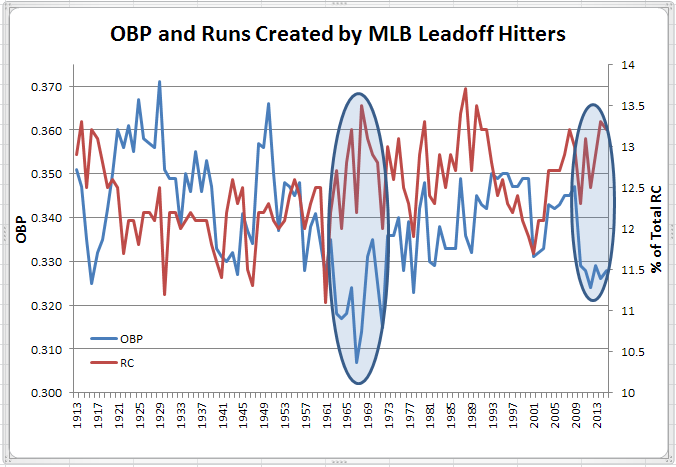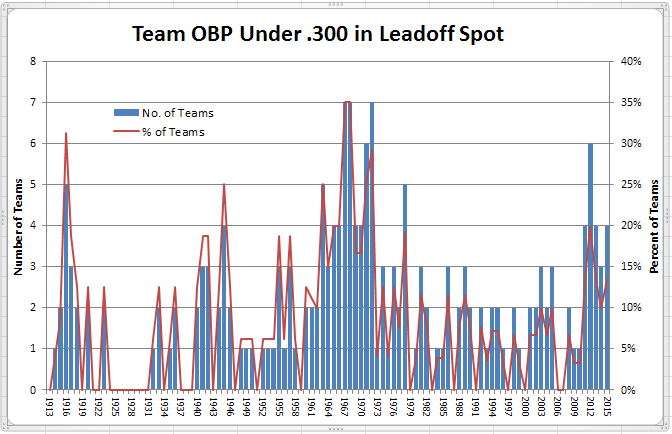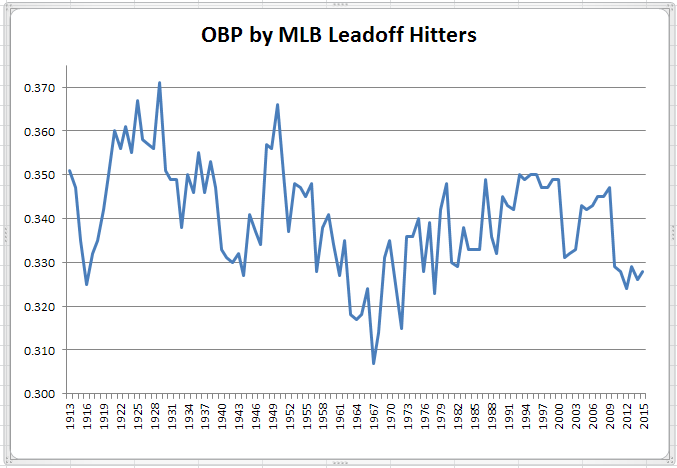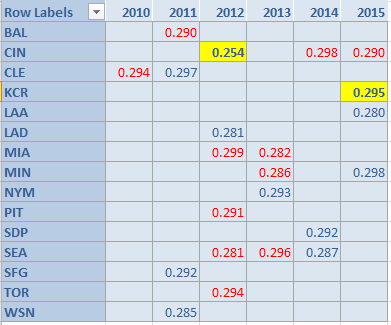Last season marked the 6th consecutive campaign with OBP below .330 for major league leadoff hitters. If it happens again in 2016, it will mark the first time since at least 1913 that that’s happened in 7 consecutive seasons. 2015 also marked the fourth straight season with at least 10% of major league teams posting a sub-.300 OBP from the number one hole; it’s the first time that’s happened in more than 40 years.
The good news (I guess) is that poor leadoff hitting didn’t stop the Kansas City Royals from becoming only the sixth team since 1913 to win the World Series with leadoff hitters posting a sub-.300 OBP. More on trends in leadoff hitting after the jump.
Here are those World Series champions with under-achieving leadoff hitters.
| Rk | Team | Split | Year | |
|---|---|---|---|---|
| 1 | KCR | Batting 1st | 2015 | .295 |
| 2 | ATL | Batting 1st | 1995 | .293 |
| 3 | OAK | Batting 1st | 1972 | .282 |
| 4 | NYY | Batting 1st | 1961 | .293 |
| 5 | DET | Batting 1st | 1945 | .295 |
| 6 | NYY | Batting 1st | 1941 | .291 |
Those 1961 Yankees were in the second of 5 straight pennant-winning seasons, four of them with sub-.300 OBP from their leadoff hitters.
| Rk | Team | Split | Year | |
|---|---|---|---|---|
| 1 | KCR | Batting 1st | 2015 | .295 |
| 2 | PHI | Batting 1st | 2009 | .294 |
| 3 | ATL | Batting 1st | 1995 | .293 |
| 4 | OAK | Batting 1st | 1972 | .282 |
| 5 | NYY | Batting 1st | 1964 | .294 |
| 6 | NYY | Batting 1st | 1963 | .283 |
| 7 | NYY | Batting 1st | 1961 | .293 |
| 8 | NYY | Batting 1st | 1960 | .272 |
| 9 | DET | Batting 1st | 1945 | .295 |
| 10 | NYY | Batting 1st | 1941 | .291 |
| 11 | BRO | Batting 1st | 1920 | .279 |
| 12 | PHI | Batting 1st | 1915 | .293 |
But, relative to that time, sub-.300 OBP from the leadoff spot wasn’t that unusual.
Then as now, over 10% of teams failed to break .300 OBP from the leadoff spot, a trend that continued in the latter part of the 1960s, peaking above one-third of major-league teams in 1967 and 1968.
Here’s what overall OBP has looked like from the leadoff spot.
For the most part, leadoff OBP has moved in tandem with run scoring, the exceptions (in the late 1920s/early 1930s, the 1950s, and late 1990s/early 2000s) coming in periods when power hitting became more prominent. But we really shouldn’t be that hard on leadoff hitters because of the their decline in OBP in the 2010s. Despite reaching base less often, their contribution to team offense has actually increased in recent years as shown in the chart below.

Now, as in the 1960s, the RC share by leadoff hitters has increased in a low run scoring environment where each run (and, thus, each baserunner) assumes greater win value. Both of these effects (lower leadoff OBP and higher leadoff RC share) should be interpreted as symptoms of a low run scoring environment, rather than one causing or influencing the other.
Which teams have struggled the most in recent years with low OBP from the leadoff spot? The table below shows that fully half of major league teams have posted at least one season in the past five with sub-.300 OBP from the leadoff spot, led by the Reds and Mariners with three seasons apiece.
The two highlighted cells are division-winning seasons, while the more numerous (half of the 22 seasons) red type denotes teams finishing 4th or lower in their divisions. That .254 OBP by the 2012 Reds (rookie Zack Cozart was the pimary leadoff hitter) is the fourth lowest leadoff mark since 1913, making their division title (aided by exceeding Pythagorean wins by 6 games) the more remarkable (the next year, with Shin Soo Choo at the top of the order, the Reds’ leadoff OBP jumped to .415, the biggest season-to-season change for a team since at least 1913; with Choo in Texas in 2014, the Reds’ leadoff OBP declined to .298, the third-largest season-to-season change).



